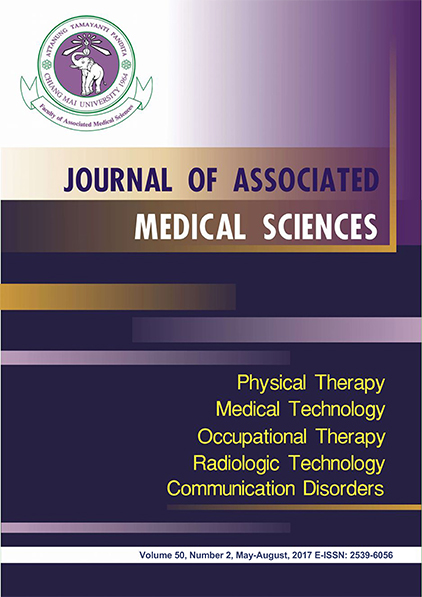Inter-fractionated dose uncertainty evaluation during radiation treatment by in vivo dosimetry with diode dosimeters
Main Article Content
Abstract
Background: Inter-fractionated dose uncertainty is one of causes of errors. Therefore, in vivo dosimetry is recommended for error detection and verifying the accuracy of dose delivery to patients.
Objectives: To evaluate inter-fractionated dose uncertainty between prescribed dose obtained from computerized treatment planning system and delivered doses from diode dosimeter.
Materials and methods: This study was performed in breast, thoracic, abdominal and pelvic regions of 20 patients. Three dimensional (3D) treatment plans were created by Pinnacle3 treatment planning system version 9.8 and verified by Delta4PT. Gamma index (at 3% dose difference and 3 mm distance to agreement) was set at 90% for acceptant level. Patients were treated with Elekta Precise Linac with 6 or 10 MV and delivered dose was collected in each fraction by p-type diode dosimeter incorporated with VivoSoft version 3.0.1.
Results: It was shown that uncertainty of delivered doses were varied from -4.432 to 2.532 percent and from -1.787 to 2.032 percent for entrance and exit dose, respectively. Uncertainty in entrance dose was higher than that of exit dose where the uncertainty in breast and pelvic regions was higher than thoracic and abdominal regions.
Conclusion: The study revealed that inter-fractionated dose uncertainty from diode dosimeter compared to computerized treatment planning system was within acceptable level of less than 5%. Therefore, treatment planning verification and in vivo dosimetry were recommended for verifying the accuracy of dose delivery to patients, to reduce errors in dose delivery in patients and improved the efficiency of radiation treatment in radiotherapy. However, diodes should be prior examined in clinic and in vivo dosimetry should be applied with caution.
Journal of Associated Medical Sciences 2017; 50(2): 314-322. Doi: 10.14456/jams.2017.32
Article Details

This work is licensed under a Creative Commons Attribution-NonCommercial-NoDerivatives 4.0 International License.
Personal views expressed by the contributors in their articles are not necessarily those of the Journal of Associated Medical Sciences, Faculty of Associated Medical Sciences, Chiang Mai University.
References
2. International Commission on radiation units and measurements (ICRU). Determination of absorbed dose in a patient irradiated by beams of X and Gamma rays in radiotherapy procedures. ICRU Report No. 24, Washington DC; 1976.
3. Zavgorodni S. “The impact of inter-fraction dose variations on biological equivalent dose (BED): the concept of equivalent constant dose.” Phys Med Biol 2004; 49: 5333–45.
4. Dam JV and Marinello G. Methods for in vivo dosimetry in external radiotherapy. ESTRO Booklet on physics for clinical No.1, 2nd edition, European Society for Radiation Oncology, ESTRO, Brussels; 2006: 1-10.
5. Bloemen E. In vivo dosimetry using MOSFET detectors in radiotherapy. Universitaire Pers Maastricht, 2009.
6. Bose R. The development of an in-vivo dosimeter for the application of radiotherapy. Centre for Sensors and Instrumentation School of engineering and Design Brunel University, Uxbridge, 2012.
7. Costa AM, Gustavo LB, Edenyse CB, Heberton F, Simone ZS, et al. In vivo dosimetry with thermoluminescent dosimeters in external photon beam radiotherapy. Applied Radiation and Isotopes 2010; 68: 760-62.
8. Huyskens DP, Bogaerts R, Verstraete J, Lööf M, Nyström H, FiorinoC,et al. Practical guidelines for the implementation of in vivo dosimetry with diodes in external radiotherapy with photon beams (entrance dose). ESTRO Booklet on physics for clinical No.1. European Society for Radiation Oncology, ESTRO, Brussels; 2001: 10-25.
9. Zhu XR. “Entrance dose measurements for in-vivo diode dosimetry: Comparison of correction factors for two types of commercial silicon diode detectors.” Med Phys 2000; 1: 100-7.
10. Allahverdi1 M and Taghizadeh MR. “Achievable accuracy in brain tumors by in vivo dosimetry with diode detectors.” J Radiat Res 2006; 3(4): 153-61.
11. Vasile G, Vasile M and Duliu OG. “In vivo dosimetry measurements for breast radiation treatments.” Romanian Reports in Physics 2012; 64(3): 728–36.
12. Fidanzio A, Greco F, Mameli A, Azario L, Balducci M, Gambacorta MA, etal. “Breast in vivo dosimetry by EPID.” Med Phys 2010; 11(4): 249-62.
13. Engstrom PE, Haraldsson P, Landberg T, Hansen HS, Engelholm S A and Nystrom H. “In vivo dose verification of IMRT treated head and neck cancer patients.” Acta Oncologica 2005; 44: 572-8.
14. Report of AAPM Radiation Therapy Committee Task Group No.62. “Diodes in vivo dosimetry for patients receiving external beam radiation therapy.” American Association of Physicists in Medicine, AAPM, Maryland; 2005: 23-46.
15. Declich F, Fumasoni K, Mangili P, Cattaneo G.M. and Iori M. “Dosimetric evaluation of a commercial 3-D treatment planning system using Report 55 by AAPM Task Group 23.” Radioth Oncol 1999, 52: 69-77.
16. Vasile G, Vasile M and Duliu OG. “In vivo dosimetry measurements for breast radiation treatments.” Romanian Reports in Physics 2012; 64(3): 728–36.
17. Tunio M, Rafi M, Ali Z, Ahmed Z, Zameer A, Hashmi A, et al. “In vivo dosimetry with diodes in a radiotherapy department in PAKISTAN.” Radiat prot dosimetry 2011; 147(3): 608-13.


